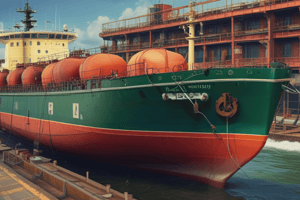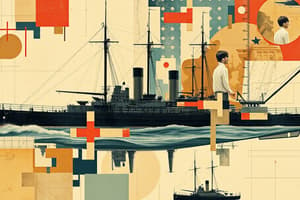Podcast
Questions and Answers
What is the primary function of the anchor chain?
What is the primary function of the anchor chain?
- To hold the anchor in place
- To absorb shock and reduce stress on the anchor (correct)
- To measure the water depth
- To connect the anchor to the vessel
Which type of anchor is suitable for rocky or weedy bottoms?
Which type of anchor is suitable for rocky or weedy bottoms?
- Grapple Anchor (correct)
- Plow Anchor
- Danforth Anchor
- Mushroom Anchor
What is the minimum recommended length of the anchor rode?
What is the minimum recommended length of the anchor rode?
- 2-3 times the depth of the water
- 3-4 times the depth of the water (correct)
- 1-2 times the depth of the water
- 5-6 times the depth of the water
Which material is more resistant to corrosion than galvanized steel?
Which material is more resistant to corrosion than galvanized steel?
What is the purpose of the anchor shackle?
What is the purpose of the anchor shackle?
Which type of anchor is used for permanent moorings?
Which type of anchor is used for permanent moorings?
What is the primary advantage of using a stainless steel anchor?
What is the primary advantage of using a stainless steel anchor?
What should be considered when selecting an anchor chain?
What should be considered when selecting an anchor chain?
Flashcards are hidden until you start studying
Study Notes
Anchor Chain
- A chain that connects the anchor to the vessel
- Composed of links that are designed to absorb shock and reduce stress on the anchor
- Typically made of galvanized steel or stainless steel
- Chain size and material depend on the size and type of vessel, as well as the sea conditions
Anchor Types
- Danforth Anchor: lightweight, compact, and has a good holding power in sandy or muddy bottoms
- Plow Anchor: also known as a plough anchor, has a hinged shank and a flat blade, suitable for most sea bottoms
- Bruce Anchor: similar to the plow anchor, but with a more robust design and better holding power
- Mushroom Anchor: used for permanent moorings, has a large, heavy weight and a holding power that increases with time
- Grapple Anchor: used for rocky or weedy bottoms, has multiple hooks that grasp the seafloor
Anchor Rode
- The combination of the anchor chain and the anchor line
- The rode should be at least 3-4 times the depth of the water to ensure the anchor sets properly
- The anchor line can be made of nylon, polypropylene, or other materials, and should be suitable for the vessel and sea conditions
Anchor Materials
- Galvanized Steel: resistant to corrosion, but may rust over time
- Stainless Steel: more resistant to corrosion than galvanized steel, but more expensive
- Aluminum: lightweight and corrosion-resistant, but may not be as strong as steel
- Titanium: strong, lightweight, and corrosion-resistant, but very expensive
Anchor Shackle
- A U-shaped fitting that connects the anchor to the anchor chain
- Should be made of a strong, corrosion-resistant material, such as stainless steel or titanium
- Should be properly sized for the anchor and chain to ensure secure connection
- May have a pin or bolt to secure the connection
Anchor Chain
- Connects the anchor to the vessel, composed of links designed to absorb shock and reduce stress on the anchor
- Typically made of galvanized steel or stainless steel, with size and material determined by vessel size, type, and sea conditions
Anchor Types
- Danforth Anchor: suitable for sandy or muddy bottoms, lightweight, compact, and has good holding power
- Plow Anchor: suitable for most sea bottoms, has a hinged shank and a flat blade
- Bruce Anchor: similar to plow anchor, but with a more robust design and better holding power
- Mushroom Anchor: used for permanent moorings, has a large, heavy weight, and holding power increases with time
- Grapple Anchor: suitable for rocky or weedy bottoms, has multiple hooks that grasp the seafloor
Anchor Rode
- Combination of anchor chain and anchor line
- Rode should be at least 3-4 times the depth of the water to ensure anchor sets properly
- Anchor line materials: nylon, polypropylene, or others, suitable for vessel and sea conditions
Anchor Materials
- Galvanized Steel: resistant to corrosion, but may rust over time
- Stainless Steel: more resistant to corrosion than galvanized steel, but more expensive
- Aluminum: lightweight, corrosion-resistant, but may not be as strong as steel
- Titanium: strong, lightweight, corrosion-resistant, but very expensive
Anchor Shackle
- U-shaped fitting connecting the anchor to the anchor chain
- Should be made of strong, corrosion-resistant material, such as stainless steel or titanium
- Properly sized for anchor and chain to ensure secure connection
- May have a pin or bolt to secure the connection
Studying That Suits You
Use AI to generate personalized quizzes and flashcards to suit your learning preferences.




